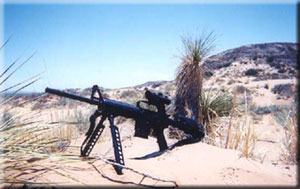|
|
| We'll be
featuring articles on a regular basis dealing with the sport of Predator
Calling. Check back often, as these articles will cycle back and forth
depending on the frequency of submission. Every article will be archived and
made available through this page. Enjoy!
Our first article is
written by one of our very own Pro Staff, Critr Gitr, Robert D. Livesay. Critr
has been hunting predators before predator hunting actually had a following.
You'll find lots of useful info in this predator hunting primer.
Click
here for a new Article on Night Hunting, By Randy Watson
|
A Predator
Hunting Primer
By Critr
Gitr, Robert D. Livesay
SOME BASICS:
A gun! I've got to have a
gun! But what gun? Rifle, handgun, or shotgun? What caliber? What gauge? What
size shot? What length barrel? Revolvers, pump, single-shot, bolt action or
semi-automatic?
The answer, or rather
answers, depends on a lot of things. Probably the first to consider is just
what you want to hunt. "Varmints", you say! Well, Arizona has a lot of
different varmints, and the best choice of a firearm depends not only on which
you intend to hunt, but also on where you intend to hunt that particular
critter.
But as soon as you zero
in on which critter, we had better check your states regulations to see what is
legal. It doesn't matter too much what we want to hunt or what we prefer to
hunt with, if it may lead us to time in the slammer!
OK, we're quite lucky in
Arizona. We can generally hunt most critters with rifle, handguns, or shotguns,
with just a few limitations. Shotguns are limited to three shot capacity.
Semi-auto centerfire rifles are limited to a magazine capacity of five rounds.
No tracer ammo, poisoned bullets, explosive warheads, or full-metal jacket
types allowed. As if we wanted to set the woods on fire and burn a hole through
our selected critter, all with the same round! OK, no shotguns larger than 10
gauge. No silencers. No machine guns!! And no shotguns shooting shot are
allowed on mountain lions.
|
Well, that still leaves
us with a few choices. Who wants to upset something the size and temper of a
lion with birdshot anyway? This is a huge subject, so we will take up the
decisions on firearms choice in another article. Meanwhile, let's get on to the
other things you may need, or just plain old want to play around with.
Camouflage clothing! Good
idea! Well, prairie dogs and ground squirrels may not care much what you are
wearing, although some folks prefer camo even for them, but other critters like
coyotes and cats have a definite preference for camo, especially for those
folks with which they are going to have the closest relationship.
|
|
|
Optics! A good,
high-quality spotting scope is definitely essential when ol' Wily comes around
the bush beside you at Mach III. Yeah, sure thing!! Actually, a good spotting
scope is really great for hunting some varmints, I just can't figure out which
ones. I suppose that some folks might want to locate rock squirrels with one,
but I prefer a much more up-close and personal technique. Prairie dogs are the
only varmint-type critter in Arizona where I can see that a spotting scope
would be a definite asset, almost a necessity, unless, of course, you're sizing
up that roundtail ground squirrel for the trophy book.
Binoculars are a nice
thing to have along. They would help in picking out that rock squirrel from
among the rocks which are likely to be the same exact color, and might help
you, if you are patient enough, to spot a jackrabbit just before he makes that
lightning dash for freedom to some other county. But binoculars are absolutely
essential for locating your next shot when you pursue the game of all game for
varmint hunters, the prairie dog. But we won't get into all the equipment for
hunting prairie dogs. As we progress, you'll discover that I don't consider
Arizona a prime spot for shooting prairie dogs, and prefer to leave that
subject to the Great Plains States.
|
|
But you
may want a cushion or stool to sit on while calling coyotes, foxes, or cats.
They can save you from becoming a human pincushion, and a folding camo stool
will elevate you just enough to give a surprisingly better view of the
landscape around you, just as a Sonoran Pussycat comes slipping in to visit.
Get the kind with a zippered bag under the seat. The compartment will be great
for carrying clippers, tail strippers, plastic bags, disposable gloves, and
such, which we will discuss later. Ladders, they seem to be gathering a
following, I'll leave that technique to someone who knows more about it than I.
You can also go the route some of the night hunters go, take for instance Randy
Watson and others, they've gone as far as developing shooting stands in the
back of their pick-ups. Not only are they comfortable, but the visibility is
extraordinary! Death from above, Predator Hunter style! You have complete
rotation on your game, a steady shooting platform and the coyotes/fox/bobcats
never see you. Rarely do they get attacked by anything that isn't on ground
level with them. Of course, we're talking ingenuity here, some elbow grease and
cost's for material.
|
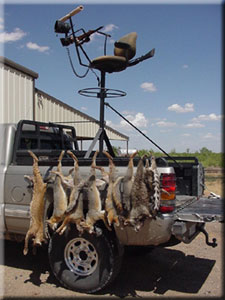 |
|
Shooting sticks
definitely help steady that rifle or pistol. You can make your own, as I do.
Many materials can be used; I used one-inch diameter dowels (smaller dowels can
be used, but I like the stiffness of the larger dowels) with a bolt through
them about six inches from one end. An aircraft-style acorn nut will give a
smooth surface and stay where you put it on the bolt. Put a couple of flat
washers between the dowels to allow them to pivot freely. After they are set
like you want, tighten the nut a couple of turns and cut the protruding bolt
off flush with a hacksaw. Then back the nut off to where it previously was set,
and it will cover the jagged end of the bolt where you sawed it off. One set of
my shooting sticks had silicone in carved depressions on each dowel, located so
as to protect the rifle finish, but after much use the silicone came loose from
the wood, so I wrapped the gun-contact area with electrical tape. That was a
temporary field fix, but has been so satisfactory that it is still that way.
The lower end of the dowels sometimes clicked together with a very unnatural
sound, so a few wraps of electrical tape on each dowel a few inches from the
bottom end muffled that sound quite nicely. For accurate handgun use, I have
one set of dowels with a cloth sling on the upper end, simply lashed to each
dowel with a shoestring. Then the handgun just nestles in the cloth sling,
suspended just above the "X" area where the dowels are connected by the bolt. I
intended this to be a quick and temporary setup for a handgun hunt, but again,
it has worked so well that I have not changed it. Looks be hanged, if it works,
use it!!! I am not in a fashion show; I just intend to kill critters! If you'd
rather not make your own shooting sticks, or want them to be as compact as
possible, consider a myriad of good shooting stick manufacturers.
Bipods are terrific in
some circumstances, and the devil's curse in others. Unfortunately, some folks
use them when they shouldn't. If you are pretty sure where your critter will
appear, by all means use a bipod, such as the excellent Harris Bipod. But if
the varmint you call in is one of the unpredictable ones which comprise about
99.9% of the population, then the last thing you need, as you are tracking a
moving coyote across in front of your stand, is a bipod attached to your rifle
and hanging it's feet in the grass and brush as you swing your rifle. That is
why I prefer shooting sticks, which can steady a shot and allow much better
bullet placement than most of us can do offhand, or can simply be discarded
with a quick push to allow a free swinging and unencumbered rifle if the
critter presents a moving shot.
|
|
GAME CALLS:
Game calls! Wow, what a
can of worms. Like gun calibers, it seems that everyone has their own opinion.
All that we can do here is give pros and cons, and our best advice, and then
just let you go ahead and write your letters objecting to what you thought that
we said.
We can break game calls down into two major groups (and this often also breaks
varmint hunters down into two distinct camps), electronic and non-electronic.
In the non-electronic group are those operated by hand by blowing through them,
those that are blown while completely inside the mouth, and all the others,
which are manipulated in some manner or the other without the benefit of
blowing through them.
|
|
Electronic calls are
typified by the Johnny Stewart call, a real workhorse of the electronic call
world. There are others, which are similar, and may even be just as good. I
wouldn't know much about them, but have owned Stewart calls since my very first
critter came hurtling through the woods to collect itself a squalling tidbit
for lunch. That was about 1960, using a model which played a 45-rpm record, and
had to have the needle arm reset every 4½ minutes or so. But it worked, and
many a fox, crow, and coyote played sucker to that call. It was simply the best
thing available at the time. But finally it gave up the ghost, and I found
myself without the necessary funds to purchase a new cassette-tape game call,
so I improvised. Putting one of the most productive rabbit squalling 45s in a
home stereo system, I copied the record over and over until I had filled a
14-minute cassette tape on both sides. Then, with the help of an adapter, I
connected the old Stewart Mid-Range varmint speaker to a small Radio Shack tape
recorder that I had on hand. The volume wasn't all that I would like for it to
have been, especially when the wind was blowing, but coyotes came to it as if
it was a thousand-dollar machine!! I began my varmint guide service doing all
my calling with nothing but that home-brewed contraption and the one homemade
tape. And it really worked!!!
I have long since retired
that old tape recorder in favor of a new Johnny Stewart tape machine purchased
by funds from my earliest clients, and after years of hard use now have it well
worn. Adding the optional 50-foot extension cord enabled me to put the speaker
out as much as 75 feet from the call. It is currently my primary backup (at
least at those times when I prefer an electronic call).
Two other electronic
calls, which I have used, are the Burnham Brothers CompuCall and the FoxPro.
The CompuCall belonged to a friend who was wintering in Arizona, and we often
went coyote hunting. He had never been successful in calling anything with the
CompuCall, which was, I believe, the first solid-state game call, and has no
moving parts. He wanted me to try it, to see if I could call game with it as
well as I was with the jury-rigged Radio Shack tape player. I probably did not
give it a really fair test, as I only used it on three stands. It did not have
nearly the volume I wanted, although it probably would have been OK if
conditions had been absolutely calm (which they rarely are here). He felt it
was inadequate, and asked me to call Burnham Brothers and discuss it with them,
to see if something could be done. I made the call, explained the problem, and
was assured that the call was working as it was designed. It was obvious (at
least to them) that anything which was wrong had to be us, not the call, and
there was, therefore, no remedy to be had by the company. As far as I know, my
friend still has the call, about 5 years later, and it's still never called in
an animal.
|
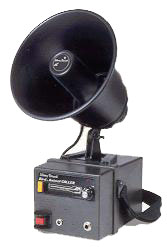
Johnny Stewart JS512
|
|
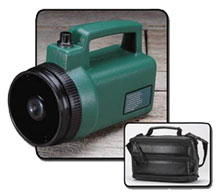
Foxpro
|
|
The other call, the
FoxPro, was brought by some hunters last year. It was a remote-controlled
solid-state model, and had been purchased with, I believe, 18 sounds on the
internal board. I liked the sounds. The sound you want was simply selected by a
switch on the remote control, and therefore could be changed quickly and
easily. I used it for two days, and called in both fox and coyote with it. It
is a very small, lightweight unit, and very handy, but I had a couple of
reservations about it. First, the remote range was much more limited than the
Dennis Kirk calls (more on them later) I had used. But in all fairness, it was
sufficient, and I could live with the limited range. Second, the volume, while
quite sufficient for the unusually calm days we hunted, was limited. I
questioned whether it was enough for most conditions I encounter on the desert.
But if I could afford a call just to use when conditions are right, it would be
the FoxPro. Note:Foxpro has since fixed the range problem and I've been told you
can call in an east coast coyote from the west coast.
Next on my electronic
acquisitions was a remote-controlled unit created by Dennis Kirk and still
marketed under his name. This unit has excellent fidelity and volume, nice on
those windy days here in the desert, and the ability to place the speaker in
brush or grass cover out at whatever distance I prefer, and in front of me
where I can watch the critters approach it. I have used this unit with both CD
and with cassette-tape players (brought on the hunt by clients), and, while the
CD player gave exquisite sound reproduction, there was not the wide variety of
sounds available as I had already accumulated on cassette tapes. Another thing,
which had an influence on my purchase selection, was that the CD player was too
large to slip into my vest or jacket pocket, as I did the tape player. So I
purchased the call with the Sony Walkman tape player, knowing that a CD player
could be purchased and used with it in the future, if desired. Why did I go to
the remote-controlled call? There were several reasons. The rechargeable
batteries in my Stewart call were weakening from age and much use, and would no
longer last for a full day of calling, so an infusion of cash was needed if it
was to remain useful. But the new call cost almost 10 times as much as new
batteries, so where is the rationale in that? It always seemed that the brush
where I really wanted to place the speaker was just 3 feet or so beyond the end
of the cord, and the remote unit allows much more flexibility in speaker
placement.
The Stewart call had
years of hard, yet faithful use already on it, and although it still functioned
perfectly, it simply could not operate trouble-free as long as a new call. The
Dennis Kirk call has more volume, and to my ear the sound fidelity is better
than the Stewart call at the upper end of the volume range. The tape player in
the Stewart call was always having trash fall into it from the brush which I
sat under and against, while the tape player with the Kirk call stays in my
hand or pocket, where it is far better protected from foreign materials which
might potentially cause wear and other problems. The tape player is the only
mechanical item in either call, and is therefore the only part subject to
mechanically wearing out. The tape player with the Kirk call is an independent
unit, not built into the call, and can be cleaned, repaired, or replaced more
easily. Last but far from least, I just wanted the new call!! I wouldn't
hesistate to reccommend any of these calls to hunters looking for the
electronic ticket. With the advances in technology taking place these days,
it's difficult to keep track of the new generations of calls. Pick what looks
and sounds right to you, I'm sure you'll enjoy their ease of use.
|
| Does
an electronic call bring in more hungries than a hand call? What are the pros
and cons of one over the other? Calling alternate stands with hand calls and my
electronic call, from daylight to dark, day after day, I managed to call in
slightly more customers with my hand calls than with my Stewart electronic
call. There was not a great deal of difference, and I am sure that the
difference was not statistically significant, but it proved to my satisfaction
that I could do at least as well with a hand call as with an electronic. So why
spend the money for an electronic? Several things enter into the decision. The
caller does not need to move as much when calling with an electronic as when
manipulating a hand call, and probably one of the primary things which
separates consistently successful callers from those who enjoy only a so-so
success rate, is how still they sit while waiting for a critter to keep them
company. When I call alone, which I commonly do, my hand cramps and hurts if I
wield a hand call all day. My fingers will blister from holding and working the
call if I do not toughen them in over a period of several days. And I seem to
have developed a bit of arthritis in my hands, so even after days of
conditioning they'll still begin hurting after a few hours of calling.
|
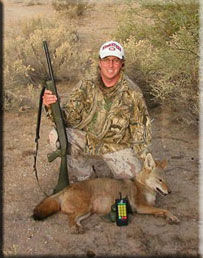
Robb/Scottsdale
with a
Extreme Dimension
Phantom Predator Call
|
| I have
killed quite a few coyotes, and while it is still a thrill when one comes in, I
have developed a passion for hunting cats, which I seldom do because most
clients are more interested in coyotes. I understand that, for calling coyote's
offers much more action. Cats supposedly respond much better to continuous
calling, which is duck soup for an electronic, but which I simply cannot do for
an hour at a time with a hand call. I am not sure how valid this need for
continuous calling is, for in spite of what I have read, I had called both
bobcats and mountain lions with my little Crit-R-Call Pee-Wee open reed hand
call. But when I do get to hunt cats, I'm usually alone. Sounding the dinner
bell out in front and away from me causes the respondent to focus on that area
and not on me. I like that for three main reasons. First, it gives me a better
chance of seeing the incoming varmint, as it will not slip up behind me.
Second, I have a much better chance of getting zeroed in on the critter than if
it were looking right at me. Third, I have a definite allergy to lion claws in
my back! |
|
Hand calls, and others:
Within hand calls are two basic types, the closed reed and the open reed. The
closed reed calls usually have a metal reed within a tube of some material.
That material is most often wood or plastic, but may be horn, antler, ivory,
metal, or whatever else you can imagine. The metal reeds are subject to failure
from fatigue, and too commonly go off-key, requiring "tweaking", or replacing.
In either case, if you don't know what sounds are OK, or when the call has gone
south, then you may be spending more of your valuable hunting time causing
critters to roll around on the ground laughing than coming to get dinner. A
slender tool is required to remove or replace a reed, and soon your call box
will resemble a master mechanic's toolbox as you accumulate all the parts and
tools needed for a few calls. The excellent Sceery calls, and possibly others
which I am not aware of, have a rubber forward portion which attaches to the
plastic rear section, with the reed sandwiched between the two sections. To
change a reed, simply pull the sections apart by hand and replace the reed,
then push the two sections together again. My personal opinion is that
closed-reed calls give more trouble than electronic calls, and if you call a
LOT, as I do, they are also more expensive in the long run.
The open-reed hand calls usually have an exposed reed of Mylar or similar
material held in place by a heavy rubber band. These are usually trouble free
unless the reed gets hung on something and damaged. Even if that happens (and I
have never had that problem), the instructions direct you to hold the reed by a
set of tweezers, dip it quickly in boiling water, and immediately drop it on a
flat surface, where it will straighten itself out. Many come with a spare reed,
which I have never needed to use. The open-reed calls are reputedly harder to
learn to use, although I feel that the difference is minimal. One important
advantage over closed-reed calls is that a wide variety if sounds can be made
with a single call, all the way from howling to puppy yelps to birdcalls. I
personally feel that the sound from the Mylar reeds is a much "purer" sound
than from the metal reeds. All hand calling in my comparison of results using
electronic calls versus hand calls was done using open-reed calls. The
open-reed calls are undoubtedly the most economical way to call critters, and
probably as effective as any way yet devised.
|

Sceery Call
|

Cronk Call
|
| If you are
a beginner, and have any difficulty with open-reed calls, try this little
trick. Wind a rubber band tightly around the mouthpiece and reed, holding the
reed down at some point on the call. Now put the call in your mouth, with your
lips past the rubber band, and blow. If it does not sound like you want it to,
just move the rubber band ever so slightly and try again. Voila, you are now
expertly and consistently making whatever sound you have selected! So why would
anyone choose to use a hand call? They cost less, at least initially. They are
much smaller and easier to carry. Many callers like the challenge of making the
sounds themselves, and some callers take it to the extreme of considering
calling an art form. That may be taking it a bit far, but all the above are
perfectly valid reasons to use hand calls. I often use hand calls exclusively
on a hunt, partly because of the challenge, but also because I participate in
hunts in a club, which advocates hand or mouth calls only. So to compete I
adhere to the club rules
|
|
A lion does not usually
respond at most calling stands, as most coyote calling is not in lion country,
although you really never know where one will turn up. And most calling stands
for coyotes or foxes are for much less time than advocated for calling lions,
so one is unlikely to show up during the stand, but again, no guarantees. Even
when not calling for cats, be sure to protect your back with a good backstop of
some kind, or sit back-to-back with your hunting partner.
A mouth call, or
diaphragm call, is contained entirely within your mouth when used, and does not
require any assistance by your hands. Therein lies the greatest advantage that
I can determine. A customer can be looking directly at you, and without moving
a visible muscle; the diaphragm call can utter just that right sound to bring
him on in to your gun. The downside is that the diaphragm call is the most
difficult of all calls to master. When one makes a sound (and a very
uncontrolled sound at that) in my mouth, it sets up such a tingling in my mouth
that I simply must spit that blasted thing out immediately. Must be doing
something wrong! Much less common, there are calls that are strictly
mechanical. They create a sound by friction-caused vibration or by mechanically
forcing air over a reed in the call. Other than to say they exist, I am not
qualified to comment further, as I have never tried one of them.
|
|
MISC:
Brush clippers, the kind you hold in one hand, are nice to help get back
further into the brush, whether it to get further into the shade on a hot day
or to help protect your back from the overly friendly wild kitty's. And there
almost always seems to be that wayward branch which is trying it's best to
occupy the same space you are sitting in. Get the bypass shear type, not the
anvil type that is commonly used for cutting flowers. And buy the best you can
afford, for some of those obnoxious branches will fight back.
After the kill, you may
want to take the tail of a fox or coyote, or need to skin it if you are
skinning the whole animal. Do not just cut it off, as the meat inside will rot
and be somewhat less that pleasant, doing nothing to aid in the preservation of
the hide. Get a tail stripper. Actually, get two in case one breaks. They are
cheap, and they work great. Just cut the skin loose from the tailbone and the
meat on it, place the stripper around the tailbone, but not any of the skin,
close the stripper, hold the animal securely, and pull!! The skin will slide
right off, leaving the bone and meat attached to the carcass. No varmint hunter
should be without this handy little device.
Flea powder is a nice
thing to have along. If you collect just the tail, slip it into something like
a bread wrapper or a zip-lock bag, dust in some flea powder, and close tightly.
Now any undesirable little critters that might be lurking in the fur will
expire very quietly, never to bother you at all. If you collect something which
you desire to take back whole, put it in a chest, bag, box, or wrap in a tarp,
and dust the flea powder liberally before closing. Now no little critters will
be crawling around and making their home in your SUV or camper.
Disposable gloves like
doctors use to embarrass and make you otherwise uncomfortable are really nice
to keep your hands clean when handling dead animals, and to prevent any
possibility of disease caused by contact with animal body fluids and other
unpleasant animal waste byproducts. The cheaper painters gloves, found where
you buy painting supplies, are cheaper and do almost as well. These cost
little, weigh almost nothing, and really are great when handling or skinning an
animal, or when stripping the tail.
Well, there you go! Have
fun!
Critr Gitr
Back
To Top
|

|

